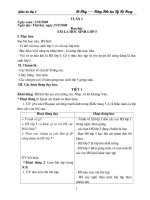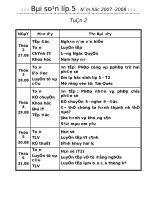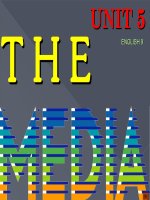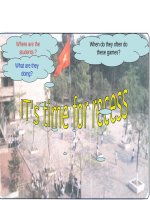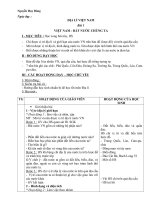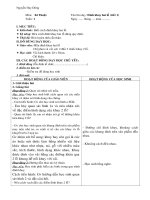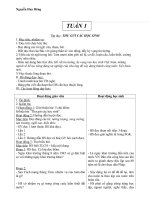5 dochieu 1
Bạn đang xem bản rút gọn của tài liệu. Xem và tải ngay bản đầy đủ của tài liệu tại đây (248.13 KB, 13 trang )
TRƯỜNG ĐẠI HỌC MỞ THÀNH PHỐ HỒ CHÍ MINH
KHOA NGOẠI NGỮ
TÀI LIỆU HƯỚNG DẪN ÔN TẬP VÀ KIỂM TRA
MÔN: ĐỌC HIỂU 1
Mục đích
Tài liệu này nhằm hỗ trợ cho học viên hình thức giáo dục từ xa nắm vững nội dung ôn tập
và làm bài kiểm tra hết môn hiệu quả.
Tài liệu này cần được sử dụng cùng với tài liệu học tập của môn học và bài giảng của
giảng viên ôn tập tập trung theo chương trình đào tạo.
Nội dung hướng dẫn
Nội dung tài liệu này bao gồm các nội dung sau:
Phần 1: Các nội dung trọng tâm của môn học. Bao gồm các nội dung trọng tâm
của môn học được xác định dựa trên mục tiêu học tập, nghĩa là các kiến thức hoặc
kỹ năng cốt lõi mà người học cần có được khi hoàn thành môn học.
Phần 2: Hướng dẫn làm bài kiểm tra. Mô tả hình thức kiểm tra và đề thi, hướng
dẫn cách làm bài và trình bày bài làm và lưu ý về những sai sót thường gặp, hoặc
những nỗ lực có thể được đánh giá cao trong bài làm.
Phần 3: Đề thi mẫu và đáp án. Cung cấp một đề thi mẫu và đáp án, có tính chất
minh hoạ nhằm giúp học viên hình dung yêu cầu kiểm tra và cách thức làm bài thi.
-1-
PHẦN 1. CÁC NỘI DUNG TRỌNG TÂM CỦA MÔN HỌC
Chương 1: SCHOOL LIFE AROUND THE WORLD
LUYỆN TẬP CÁC KỸ NĂNG VÀ LÀM CÁC DẠNG BÀI TẬP SAU:
Dự đoán nội dung bài đọc
Nhận ra cấu trúc bài đọc
Xác định câu chủ đề
Đoán nghĩa từ ngữ cảnh
Tóm tắt
ĐỌC CÁC PHẦN SAU:
Phaàn 1: International Students (trang 5)
Phaàn 2: University Life Around the World (trang 10)
Phaàn 3 : Vocabulary and Language Learning Skills (trang 15)
Phaàn 4: Focus on Testing (trang 18)
Chöông 2: EXPERIENCING NATURE
LUYỆN TẬP CÁC KỸ NĂNG VÀ LÀM CÁC DẠNG BÀI TẬP SAU:
Hiểu ý chính
Tóm tắt
Xác định từ đồng nghĩa
Xác định nguyên nhân và hệ quả
Nhận ra tiêu đề và chủ đề đoạn văn
Nhận ra các chi tiết
ĐỌC CÁC PHẦN SAU:
Phần 1: The Powerful Influence of Weather (trang 23)
Phần 2: Global Climate Changes (trang 31)
Phần 3: Vocabulary and Language Learning Skills (trang 33)
Phần 4: Focus on Testing (trang 37)
Chương 3: LIVING TO EAT or EATING TO LIVE
LUYỆN TẬP CÁC KỸ NĂNG VÀ LÀM CÁC DẠNG BÀI TẬP SAU:
Hiểu ý chính
Nhận ra chi tiết
-2-
Nhận dạng dữ kiện và quan điểm
Phân loại từ
ĐỌC CÁC PHẦN SAU:
Phần 1: Global Diet Choices (trang 44)
Phần 2: Facts about Food (trang 49)
Phần 3: Vocabulary and Language Learning Skills (trang 53)
Phần 4: Focus on Testing (trang 58)
Chương 4: IN THE COMMUNITY
LUYỆN TẬP CÁC KỸ NĂNG VÀ LÀM CÁC DẠNG BÀI TẬP SAU:
Nhận ra chủ đề của từng đoạn văn và chủ đề của toàn bài đọc
Hiểu ý chính của từng đoạn và ý chính của toàn bài đọc
Tìm các thí dụ dùng để giải thích nghĩa của từ
Nhận ra mối quan hệ giữa chi tiết và điểm chính
Đọc lướt để tìm chủ đề và ý chính
Tóm tắt
Nhận ra từ có cùng nghĩa
Nhận ra danh từ và động từ
ĐỌC CÁC PHẦN SAU:
Phần 1: How Can I Get to the Post Office? (trang 63)
Phần 2: The Laws of Communities (trang 71)
Phần 3: Vocabulary and Language Learning Skills (trang 75)
Phần 4: Focus on Testing (trang 81)
Chương 5: HOME
LUYỆN TẬP CC KỸ NĂNG VÀ LÀM CÁC DẠNG BÀI TẬP SAU:
Nhận ra các đoạn văn được viết theo thứ tự thời gian
Hiểu ý chính
Sử dụng dấu chấm câu và cụm từ chuyển tiếp để hiểu nghĩa của từ và cụm tư2
Nhận ra các dữ kiện liên quan đến thời gian
Tóm tắt
Dự đoán
Nhận ra từ đồng nghĩa và trái nghĩa
Nhận ra danh từ và tính từ
-3-
ĐỌC CÁC PHẦN SAU:
Phần 1: A Short History of the Changing Family (trang 87)
Phần 2: Time with the Family – Past and Present (trang 94)
Phần 3: Vocabulary and Language Learning Skills (trang 99)
Phần 4: Focus on Testing (trang 103)
Chương 6: CULTURES OF THE WORLD
LUYỆN TẬP CC KỸ NĂNG V LM CC DẠNG BI TẬP SAU:
Nhận ra các câu nói trực tiếp trong dạng đoạn văn
Hiểu điểm chính
Hiểu nghĩa từ ngữ cảnh
Nhận ra các chi tiết hỗ trợ cho các quan điểm
Tóm tắt
Đưa ra quan điểm
Nhận ra danh từ, động từ và tính từ
ĐỌC CÁC PHẦN SAU:
Phần 1: Cross-Cultural Conversation (trang 109)
Phần 2: Clues to the World Cultures (trang 115)
Phần 3: Vocabulary and Language Learning Skills (trang 120)
Phần 4: Focus on Testing (trang 126)
Chương 7: HEALTH
LUYỆN TẬP CÁC KỸ NĂNG VÀ LÀM CÁC DẠNG BÀI TẬP SAU:
Nhận ra và lập dàn ý của bài đọc
Đưa ra lời khuyên và giải quyết vấn đề
Nhận ra và chọn tiếp vĩ ngữ
Hiểu thông tin chỉ dẫn cấp cứu
Trình bày kinh nghiệm và ý kiến cá nhân
ĐỌC CÁC PHẦN SAU:
Phần 1: The Secrets of a Very Long Life (trang 133)
Phần 2: Claims to Amazing Health (trang 141)
Phần 3: Vocabulary and Language Learning Skills (trang 147)
Phần 4: Focus on Testing (trang 155)
-4-
Chương 8: ENTERTAINMENT AND THE MEDIA
LUYỆN TẬP CÁC KỸ NĂNG VÀ LÀM CÁC DẠNG BÀI TẬP SAU:
Nhận ra các điểm tương đồng và tương phản
Hiểu ý chính
Hiểu từ vựng hay các chi tiết cụ thể
Phân loại các câu chuyện
Sắp xếp các sự kiện theo thứ tự
Tóm tắt
Nhận ra tiếp vĩ ngữ
Xác định các từ có cùng gốc
ĐỌC CÁC PHẦN SAU:
Phần 1: How the Visual Media Affect People (trang 161)
Phần 2: Media Stories (trang 167)
Phần 3: Vocabulary and Language Learning Skills (trang 173)
Phần 4: Focus on Testing (trang 181)
Chương 9: SOCIAL LIFE
LUYỆN TẬP CÁC KỸ NĂNG VÀ LÀM CÁC DẠNG BÀI TẬP SAU:
Lập dàn ý bài đọc
Hiểu ý chính
Sử dụng ngữ cảnh để hoàn tất các chi tiết
Suy luận
Tóm tắt
Nhận ra các tiếp đầu ngữ mang nghĩa phủ định
Trình bày kinh nghiệm và ý kiến cá nhân
ĐỌC CÁC PHẦN SAU:
Phần 1: Meeting the Perfect Mate (trang 188)
Phần 2: Meeting the Perfect Mate (trang 195)
Phần 3: Vocabulary and Language Learning Skills (trang 200)
Phần 4: Focus on Testing
-5-
PHẦN 2. HƯỚNG DẪN LÀM BÀI KIỂM TRA
HÌNH THỨC KIỂM TRA
Đề thi gồm 2 bài đọc từ các nguồn khác (không trích từ giáo trình chính) kèm theo
các phần câu hỏi dùng để kiểm tra kỹ năng đọc hiểu. Đây là một số dạng câu hỏi
thường gặp:
Trắc nghiệm nhiều chọn lựa
Câu trả lời ngắn
Hoàn chỉnh câu
Hoàn chỉnh bản ghi chú, tóm tắt, và bảng biểu
Chọn tựa đề, chủ đề, ý chính cho các đoạn văn
Nhận biết quan điểm, thái độ của tác giả.
Phân loại
Đánh số các dữ kiện theo thứ tự
HƯỚNG DẪN LÀM BÀI
Đọc thật kỹ bài đọc trước khi trả lời câu hỏi
Hãy đọc cẩn thận lời hướng dẫn để hiểu chính xác điều yêu cầu và dạng phải
làm
Khi đọc câu hỏi cần nhận ra:
o loại câu hỏi cần phải trả lời ( điền và chổ trống, trắc nghiệm, ghép thông
tin phù hợp)
o câu hỏi cần phải trả lời cụ thể hay trả lời chung
o dạng trả lời nào cần phải sử dụng (số, ngày, tháng, lý do)
-6-
PHẦN 3. ĐỀ THI MẪU VÀ ĐÁP ÁN
Môn thi: ĐỌC HIỂU 1 - ĐỀ 0
THỜI GIAN: 75 PHÚT
Sinh viên không sử dụng tài liệu và từ điển
Sinh viên làm bài trên đề thi
Họ và tên thí sinh: ___________________________________
Chữ ký Giám thị 1
Ngày sinh: _________________________
Mã số sinh viên: ___________________ Phòng thi: ________
Chữ ký Giám thị 2
Lớp: _________________
ĐIỂM SỐ:
ĐIỂM CHỮ:
CHỮ KÝ GIÁM KHẢO:
Read the following reading selections and do what you are required.
SELECTION 1
1
Composer David Cope is the inventor of a computer program that writes original
works of classical music. It took Cope 30 years to develop the software. Now most
people can’t tell the difference between music by the famous German composer J.S.
Bach (1685–1750) and the Bach-like compositions from Cope’s computer.
2 It all started in 1980 in the United States, when Cope was trying to write an opera.
He was having trouble thinking of new melodies, so he wrote a computer program to
create the melodies. At first this music was not easy to listen to. What did Cope do?
He began to rethink how human beings compose music. He realized that composers’
brains work like big databases. First, they take in all the music that they have ever
heard. Then they take out the music that they dislike. Finally, they make new music
from what is left. According to Cope, only the great composers are able to create the
database accurately, remember it, and form new musical patterns from it.
3 Cope built a huge database of existing music. He began with hundreds of works by
Bach. The software analyzed the data: It broke it down into smaller pieces and
looked for patterns. It then combined the pieces into new patterns. Before long, the
program could compose short Bach-like works. They weren’t very good, but it was a
start.
4 Cope knew he had more work to do – he had a whole opera to write. He continued
to improve the software. Soon it could analyze more complex music. He also added
many other composers, including his own work, to the database.
-7-
5
A few years later, Cope’s computer program, called “Emmy,” was ready to help
him with his opera. The process required a lot of collaboration between the
composer and Emmy. Cope listened to the computer’s musical ideas and used the
ones that he liked. With Emmy, the opera took only two weeks to finish. It was
called Cradle Falling, and it was a great success! Cope received some of the best
reviews of his career, but no one knew exactly how he had composed the work.
6 Since that first opera, Emmy has written thousands of compositions. Cope still
gives Emmy feedback on what he likes and doesn’t like of her music, but she is
doing most of the hard work of composing these days!
I. Circle the letter of the correct answer. (5 x 0.2 = 1 point)
1. What kind of music does David Cope compose?
a. classical music
b. many different kinds of music
2. What was Cope’s goal?
a. He wanted to study Bach’s music.
b. He wanted to write an opera.
3. What did Cope realize about a composer’s brain?
a. It works like a big database.
b. It can create melodies.
4. Who is Emmy?
a. a composer who helped David Cope
b. a computer program
5. Who wrote the opera Cradle Falling?
a. David Cope
b. David Cope and a computer program
II. Find these words in the selection. Then match the words with their meanings.
Write the letters of your answers on the short lines . (6 x 0.2 = 1.2 points)
______1. original (par. 1)
______2. analyze (par. 4)
______3. complex (par. 4)
books
______4. collaboration (par. 5)
a. information that tells you how well or
badly you’re doing something
b. reports that give opinions about music,
or plays
______5. reviews (par. 5)
c. not a copy
______6. feedback (par. 6)
d. study something in a careful way
e. having many parts
f. the act of working together
-8-
III. Number the events in the order they happened, from 1 (first) to 8 (last). The
first one is marked for you. (7 x 0.4 = 2.8 points)
____a. The computer software analyzed the database and created new patterns of
music.
____b. He wrote a computer program to create the melodies for him.
____c. The computer program helped Cope write a successful opera.
____d. Cope built a huge database of existing music.
____e. He had trouble thinking of new melodies for the opera.
____f. Cope kept improving the software.
1 g. David Cope wanted to write an opera.
____h. The program didn’t write very good music.
SELECTION 2
A desert is a hot, dry, sandy place. A desert is also a beautiful land of silence and
space. The sun shines, the wind blows, and time and space seem endless. Nothing is
soft. The sand and rocks are hard, and many of the plants, such as the cactus, have
hard needles instead of leaves.
The size and location of the world’s deserts are always changing. Over millions of
years, as climates change and mountains rise, new dry and wet areas develop. But
within the last 100 years, deserts have been growing at a frightening speed. This is
partly because of natural changes, but the greatest desert makers are humans.
In the 19th century some people living in English colonies in Australia got rabbits
from England. Today there are millions of rabbits in Australia, and they eat every
plant they can find. The great desert that covers the center of Australia is growing.
The land in the southwestern United States is rich. Large farms grow crops that
need a lot of water, but there is only a little rainfall in that part of the country. The
level of the water table underground is decreasing every year.
Farming first began in the Tigris-Euphrates Valley, but today the land there is a
desert. In dry areas, people plant crops on land that is poor and dry. When there are
one or two very dry years, the plants die, and the land becomes desert. Animals such
as goats, sheep, and cattle eat every plant they can find until there is nothing left at
all.
In developing countries, 90 percent of the people use wood for cooking and
heating. They cut down trees for firewood. But trees are important. They cool the
land under them and keep the sun off smaller plants. When leaves fall from a tree,
they make the land richer. When the trees are gone, the smaller plants die, and there
is nothing but sand. Yet people must use firewood, raise animals, and grow crops in
order to live.
-9-
Humans can make deserts, but humans can also prevent their growth. Algeria
planted a green wall of trees across the edge of the Sahara to stop the desert sand
from spreading. Mauritania planted a similar wall around Nouakchott, the capital.
Iran puts a thin covering of petroleum on sandy areas and plants trees. The oil keeps
the water and small trees in the land, and men on motorcycles keep the sheep and
goats away. Other countries build long canals to bring water to desert areas.
Yet land that will probably become desert in the future equals the size of
Australia, the United States, and the former Soviet Union together. Can people stop
the growth of the world’s deserts and save the land that is so essential to life?
I. Give short answers to the following questions. (5 x 0.4 = 2 points)
1. What makes the size and location of deserts change?
_________________________________________________________________________
_________________________________________________________________________
2. What happened in Australia to make the size of the desert increase?
_________________________________________________________________________
_________________________________________________________________________
3. Why is the level of the water table underground decreasing in the southwestern
United States?
_________________________________________________________________________
_________________________________________________________________________
4. Why do deserts grow when people cut down trees?
_________________________________________________________________________
__________________________________________________________________________
_________________________________________________________________________
_________________________________________________________________________
5. Describe some of the things that countries are doing to stop deserts from growing.
_________________________________________________________________________
_________________________________________________________________________
_________________________________________________________________________
II. Write T (True) or F (False) on the lines according to what is stated or implied
in the selection. Write NI (No Information) if there is not enough information in
the selection to answer true or false. (5 x 0.4 = 2 points)
- 10 -
______1. In general, desert plants have large, beautiful flowers.
______2. Some countries are building canals to bring water to the deserts.
______3. The size of deserts has changed greatly in the past 100 years, but it did not
change before that.
______4. Australia was once an English colony.
______5. The size of the world’s deserts will probably increase before people stop
the growth.
III. Below are two main ideas of the selection. Choose the supporting details that
relate to each main idea and write the letters of your answers under the correct
main idea. Use only six of the supporting details in the list. Three of them do not
belong in either column. The first one has been done as an example. (5 x 0.4 = 2
points)
Main Ideas
1. Humans make deserts
________c_________
__________________
__________________
2. Humans can stop the growth of deserts
__________________
__________________
__________________
Supporting Details
a. Algeria is planting a green wall to stop the Sahara.
b. A desert is a beautiful land of silence and space.
c. English people brought rabbits to Australia.
d. People cut down trees for firewood.
e. Some countries are building canals to bring water to desert areas.
f. Many desert plants have needles.
g. Goats, sheep, and cattle eat every plant they can find.
h. Iran puts petroleum on sandy areas and plants trees.
i. Desert sand and rocks are hard.
THE END
- 11 -
ĐÁP ÁN ĐỀ THI SỐ ____
MÔN THI: ĐỌC HIỂU 1
THỜI GIAN: 75 PHÚT
READING SELECTION 1
I. (5 x 0.2 = 1 point)
1. What kind of music does David Cope compose?
a. classical music
b. many different kinds of music
2. What was Cope’s goal?
a. He wanted to study Bach’s music.
b. He wanted to write an opera.
3. What did Cope realize about a composer’s brain?
a. It works like a big database.
b. It can create melodies.
4. Who is Emmy?
a. a composer who helped David Cope
b. a computer program
5. Who wrote the opera Cradle Falling?
a. David Cope
b. David Cope and a computer program
II. (6 x 0.2 = 1.2 points)
___c___1. original (par. 1)
___d___2. analyze (par. 4)
___e___3. complex (par. 4)
a. information that tells you how well or
badly you’re doing something
b. reports that give opinions about music,
books or plays
___f___4. collaboration (par. 5)
___b___5. reviews (par. 5)
c. not a copy
___a___6. feedback (par. 6)
d. study something in a careful way
e. having many parts
f. the act of working together
III. (7 x 0.4 = 2.8 points)
__6__a. The computer software analyzed the database and created new patterns of
music.
__3__b. He wrote a computer program to create the melodies for him.
__8__c. The computer program helped Cope write a successful opera.
__5__d. Cope built a huge database of existing music.
__2__e. He had trouble thinking of new melodies for the opera.
__7__f. Cope kept improving the software.
- 12 -
1 g. David Cope wanted to write an opera.
__4__h. The program didn’t write very good music.
READING SELECTION 2
I. (5 x 0.4 = 2 points)
1. Nature and human beings change the size and location of deserts.
2. People brought rabbits from England, and the rabbits eat most of the plants.
3. Because large farms use a lot of water to grow crops.
4. The trees cool the land and keep the sun off the smaller plants. When the trees
are gone, the smaller plants die, and there is nothing but sand.
5. Planting trees, putting petroleum on sandy areas, keeping animals away, and
building canals.
II. (5 x 0.4 = 2 points)
__NI___1. In general, desert plants have large, beautiful flowers.
___T___2. Some countries are building canals to bring water to the deserts.
___F___3. The size of deserts has changed greatly in the past 100 years, but it did
not change before that.
___T___4. Australia was once an English colony.
___T___5. The size of the world’s deserts will probably increase before people stop
the growth.
III. (5 x 0.4 = 2 points)
Main Ideas
1. Humans make deserts
________c_________
________d__________
________g__________
2. Humans can stop the growth of deserts
________a__________
________e__________
________h__________
- 13 -
